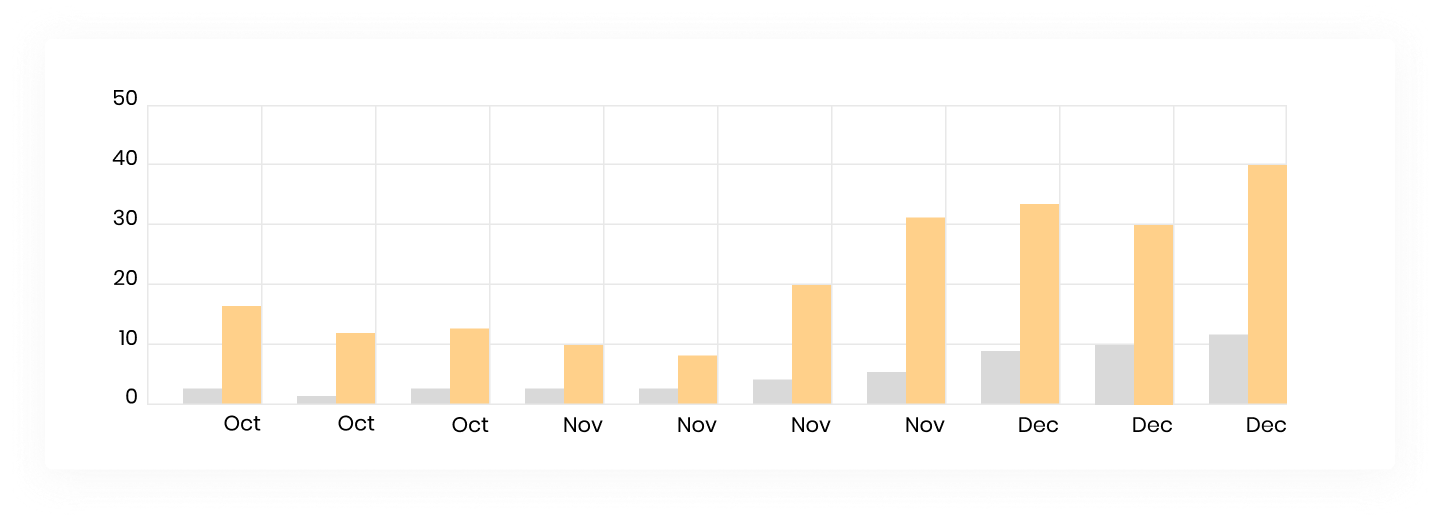Why do I call it “boutique”?
- It’s a certified European company run by qualified experts who follow European working practices and quality standards while offering budget-friendly pricing.
- The company has over 70 developers who specialize in exclusivity, high customization options, and a personalized, human-centric approach.
- The company has a competent sales team that puts a lot of effort into building warm B2B relationships with each new client.
While it may not sound much given the diversity and size of the global software development market, such qualities are quite rare and highly appreciated among potential clients.
My tasks
Essentially, I was tasked to boost the client’s in-house sales team’s performance, increase their average close rate, and help them set up appointments. To achieve this, I collaborated with the client’s b2b outside sales managers, building up the following strategy.
1. Lead research
Our Research department explores and gathers business leads that match the client’s ICP. At the beginning of our cooperation, I was supplied with between 2,000 and 2,800 relevant leads to process. It’s worth noting that such a large number of leads is crucial. The field of software development is highly competitive. When there are so many vendors and services to choose from, you’re quite likely to get objections from potential buyers. So, the more leads you work with, the higher are your chances of increasing your number of appointments.
2. Sending and writing emails
Once a comprehensive lead database is built, the outreach phase begins. Our template copywriters create customized emails that take data covered by ICP into account to create a highly personalized introduction and invite recipients to a sales conversation.
As always, we create several email sequences to make sure we send as many messages as it’s required to get the prospect’s attention.
It’s crucial to build a proper schedule for sending emails and know how to make a pause. For this, you have to know your prospects’ industry, average company size, geographic location as well as countries, states, or areas your prospects sell to.
This information should dictate your cadence, the pauses you make between your emails, and how many messages you must send exactly.
In general, I chose to follow up with prospects every two days after the first email. If I hadn’t received a response within a two-week time, I’d reduce the frequency and number of emails down to one follow-up message per month.
When your prospect remains unresponsive within 14 business days, increasing the number of emails won’t do you any good. At best, you’ll be ignored, at worst, you’ll be marked as spam. It’s best to back off gracefully, sending a reminder about your services every once in a while.
The shorter your follow-ups are, the better. Your prospect shouldn’t waste much time one replying to you. If your template doesn’t make it possible to reply with a short “yes” or “no”, it should be rewritten.
3. Processing replies
After sending emails, I process all the replies, break them down into positives and negatives, and approach each response with an individual strategy. For example, within the course of my cooperation with the client, I received around 70% of negative replies — this is completely normal for a competitive sphere like software development.
However, getting sales objections is not always the end of the line. Of course, there were negative replies where the prospect made their lack of interest in purchasing any services loud and clear — in those cases, agreeing with them and removing their emails from the outreach campaign is the only reasonable thing to do. However, some replies allowed me to continue the conversation for a little while.
Most of the prospects who replied negatively said something along the lines of “I can’t use your services right now.” For them, I developed a campaign that consisted of the following messages:
|
Message # 1: Asking for clarifications. It never hurts to ask your prospects why they can’t work with you right now. As long as you don’t come off as pressuring or commanding, you can expect an honest response. |
In our messages, we mention that we need that information to gain a better understanding of our target audience and always thank our recipients for their input.
|
Message # 2: Giving food for thought. This type of email depends on the kind of reasons your prospects provide. In my case, “I already have a vendor” was the main cause for refusing our sales offer. Once again, you shouldn’t try and convince your prospects to change their mind on the spot. You’ll fail and leave a bad impression. |
Instead, I informed the prospects the client’s offer still stands and recommended they contact us when they will be planning their budget for the next season. I also always offered to take a look at the pricing and compare it with the costs charged by their current vendor.
Sometimes, I also asked the prospects to elaborate on their vendor’s qualities and assets to see what my client has to compete with.
Regarding positive replies, I received around 30%. Mind that by positive I don’t mean an instant “Yes, sign me in!”. It sounds like magic, and no prospect would respond like that after the introduction email.
Positive replies indicate the prospect’s interest. For example, your prospects may ask you about the pricing or request a couple of case studies. That means they are ready to explore your product and services but still haven’t made up their mind. It’s up to you to keep fueling their interest until they become determined about working with you.
However, that’s not all. You have to distinguish between positive and faux-positive replies. For example, in my experience, when prospects reply to your introduction email by asking about the price, it doesn’t guarantee their interest. In many cases, it turns out to be a polite way to end the sales conversation they don’t intend to engage in right now.
Meanwhile, if your prospects inquire about the company’s experience of working on a certain type of project, you’re more likely to score an appointment in the end. When your prospects are specific in their questioning, you just know that they need a solution and they hope to find it in your services.
4. Booking a meeting
It’s hard to say how many emails and follow-ups it can take before the prospect agrees to a meeting. With some prospects, you may score an appointment setting after just two emails, while other prospects may agree to a meeting after two weeks. Whenever you reach the appointment-making stage, pretty much anything can happen.
Whenever the prospect agrees to an appointment, I make an accordion record in the Calendly. After this, I hand the prospect over to the client’s sales managers. It means that I provide them with all the data I have gathered during my communication.
It’s worth noting that the process was a bit messy in the beginning because we didn’t have a single platform for organizing prospect data. However, as soon as we made Pipedrive our tool of choice, the process became almost intuitive to me. With Pipedrive, I was able to quickly build a detailed data profile that would let the sales managers know:
- when the first message was sent;
- how many emails were sent to the prospect in total;
- when the prospect responded;
- how much time passed between each message;
- how many sequences it took to make an appointment;
- which campaign brought the prospect.
After this, I send the link to Pipedrive to the available sales manager in Slack. Then I stay in touch with the client’s sales executives, checking up with their progress once a week to make sure that their communication goes smoothly.
The collaboration between the client’s in-house sales teams and our teams is highly important. It grants a better vision of the client’s prospects and reduces the risks of no-shows.
Project highlights
So, with my tasks and duties established, let’s take a look at how much progress we made.
This project had its ups and downs. There were three bad periods instantly followed by periods of great performance.
Since October, we were targeting the United States, receiving many positive replies.

However, after December and till February, I got more meetings from follow-ups than the introduction emails.
As we entered March, the performance didn’t improve, prompting us to change our targeting from the United States to Europe (Germany and France, in particular). As you can see from the graph below, we were successful and our European campaigns were delivering good results up to July.

Nevertheless, the same graph shows that we saw a decrease in appointments in August. That month we were barely able to squeeze out a single appointment!
So, I had to come up with a new strategy.
To me, it's a natural thing to do but it’s still worth mentioning. When you want to change your strategy, always consult with your client’s in-house sales teams. They’re responsible for all the resources invested in campaigns, so they should have a clear understanding of what’s going on and what to expect. Also, they provide valuable professional insights that help you find the best solution possible.
Despite the low performance, we didn’t stop targeting Europe completely. Instead, we:
- concentrated on the campaign that nurtured F2F-meetings;
- stopped all other outreach campaigns;
- shifted our focus from Germany to Ireland and the Netherlands.
Slowly but surely, it worked out for us — starting with a rather slow September and October, we made it through December and managed to pick up the speed in January. Since then, we were pushing out 10 to 14 appointments per month. For a company operating in software development, it’s an amazing result.
Why did it work?
In my opinion, the success of the campaign was defined by several factors.
- Seasonality. January is a hot month for many businesses. This is when people make plans for the coming year and try to find the right assets and the right vendors for achieving their goals. Therefore, prospects become more active and eager to respond. I’ve never experienced “slowness” in January.
- Targeting. Narrowing down our ICP, we started prioritizing companies with digital products. Such companies often need assistance with growing pains and maintenance, so it made sense to reach out to them and offer support.
- F2F meetings. Also, making an emphasis on F2F meetings contributed to the success of the campaign a lot. Many business owners appreciate transparency and flexibility. If they can meet the representative of their potential vendor in person, it establishes a human connection and injects more credibility into both unique value propositions and assets. Currently, F2F emails for Europe make up the core of our outreach.
Additionally, we started targeting the United States again by offering mobile app development services. Our LinkedIn research was a great help in finding decision-makers.
Results: numbers, challenges, and recommendations
So, what did I achieve after working with the client for a year and a half? From my side, it took me 5 mailboxes, 2-3 hours per day, and between up to 2,800 leads to:
- Score around 56 meetings.
- Increase the average close rate by 10%.
- Help the client to close more valuable customers, earning around 500,000 USD in revenue.
Speaking of challenges I had to encounter, it wasn’t about a high workload or a high percentage of negative replies. You can get used to both of these by building your schedule and developing an individualized strategy for sales objections you encounter. I ran into different kinds of difficulties:
- Feedback speed. Even when I got positive replies from interested customers, I found myself going through a rather long sales cycle because prospects kept asking for specific information about the client’s experience of working with a certain digital product/digital tool. Since I didn't have that information, I had to reach out to the client’s sales managers.
Meanwhile, they had a lot of tasks to handle, so they weren’t able to answer immediately. All that ended up in both me and my prospect waiting. This is why I now suggest creating a deck that would display the client’s experience and provide me with all insights — even those that seem too specific or not worth mentioning in the introduction email.
The faster you reply, the less time your prospects have to start doubting their choices or changing their mind. It will also make all participants of the project less stressed out and more comfortable with their tasks.
- Time zones. That remains an issue with our campaigns for the United States. I have to choose the most convenient time slots to make sure that the client’s sales managers don’t work overtime to jump on a call with the prospect — and that the prospect can meet the sales managers comfortably.
So, in my experience, it always pays to have many different sales decks prepared. This way, you can provide your prospects with interesting content and indulge their curiosity in the most illustrative way possible.
My work with the client is not over yet but I’m confident that the current results are merely the beginning. The quality of the client’s services combined with our data and outreach tools creates a large plethora of possibilities.
As for my personal advice, don’t let setbacks stop you. If you see your performance dropping, don’t panic. Think about how you can make the most out of the current situation or look for a direction that would be the most beneficial to you.



